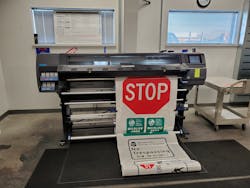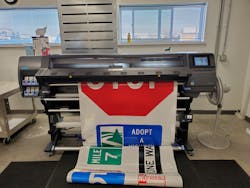The Washington State Department of Transportation (WSDOT) operates 18,600 lane miles of state highways. Maintaining quality signage throughout the state is a key part of ensuring that the motoring public travels safely and efficiently.
For years, WSDOT’s Union Gap, WA-based sign shop relied on conventional methods like screen printing for its in-house roadway signage production. When the sheeting industry approached the department to pitch a shift to digital sign printing around 10 years ago, WSDOT took a “wait and see approach,” according to State Sign Engineer Rick Mowlds. At the time, there was no state specification for digital printing. Fast forward to today, and the sign shop has fully transitioned to digital operations and is beginning to reap the benefits.
Developing a Specification
In previous years, Mowlds said the department was apprehensive about digital printing because of the upfront cost of the equipment. But as the industry progressed over time and costs started to come down, WSDOT began to take a closer look at digital printing again in 2015. After learning more and seeing the benefits, the department ultimately decided to make the change and published its digital specification in 2018.
Developing the new specification took the better part of a year, involving conversations with WSDOT’s materials lab and sheeting manufacturers—with multiple revisions along the way.
Once the specification was finalized, WSDOT got to work transforming its sign shop, removing solvents and turning its screen printing room into a graphics room. The sign shop worked with Washington state universities to lease digital printers through an existing contract. After a short period of growing pains adjusting to the new equipment and software, the new and improved sign shop was up and running smoothly by 2019.
Today, WSDOT is manufacturing about 60 percent of its signs in-house, with the rest produced by external fabricators. The sign shop has the capability of making a wide variety of signs, from stop signs all the way to large overhead signs.
After soliciting bids from a number of vendors, WSDOT has opted for using components backed by the 3M™MCS™ Warranty for Traffic, including qualified digital printers and inks, 3M reflective sheeting and overlay films. During the bidding process, Mowlds was struck by the cost-effectiveness and longevity of 3M’s options.
“Basically as with anything in the transportation system, you're always looking at trying to lower your life cycle costs,” he said, adding that the durability of digitally printed products means signs will last longer on the roadways.
Signs of Success
Since shifting to digital printing, Mowlds said WSDOT’s sign shop has already seen less waste.
“From what I'm being told from our sign shop, they've been able to maximize each roll of sheeting more than they could in the past,” Mowlds said.
Digital printing is also reducing the amount of time spent on each sign. Certain signs—like a “school bus stop ahead” sign—used to involve a hands-on, labor-intensive silk-screening process.
“First we'd silk screen the black on it, and then they'd have to run the red sheeting through a plotter and then hand apply it,” Mowlds said. “Now with the digital printing, it’s all done in one step.”
For Mowlds, the need for durable signage for Washington’s scenic byways drove home the benefits of digital printing. With the previous printers, these signs—displaying a unique logo for each byway—only lasted five to ten years at the most. With the digital printers, he said WSDOT can count on the signs to last longer on the roads.
For other state DOTs or local agencies considering a move to digital sign printing, Mowlds suggests checking out the American Traffic Safety Services Association’s digital printing guide along with seeking out sheeting manufacturers that provide a certification process for sign fabrication companies. After seeing the benefit of digital printing at WSDOT, he ultimately recommends establishing a digital sign specification.
“The industry is moving that way and silk screening is going to go by the wayside, so it's coming whether you like it or not,” he said. “There's benefits; it's as good or better than silk screening in terms of durability, in some cases it's less labor intensive and hopefully we'll see additional cost savings down the road.”
Visit 3M to learn more about digitally printing traffic signs or developing a digital specification for your agency.

